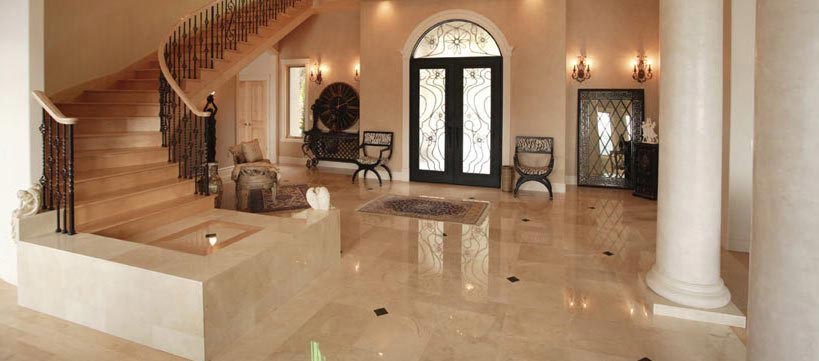Marble & granite floors are durable, but knowing how to clean them is important. Find out useful info on the best marble cleaners & cleaning techniques.
Top Tip
If you spill something on your granite or marble floor, it’s important to clean it off as quickly as possible, as these surfaces stain incredibly easily. Acidic liquids like orange juice or vinegar can be particularly troublesome. Blot (rather than wipe) any spills with a cloth, before washing with a little dishwashing liquid and a liberal dose of water.
Key Steps:
A liquid soap, like Vim dishwashing liquid, combined with water can be used to spot clean and mop granite and marble floors. This solution is mild enough that it can treat your granite or marble floors with the special care they need, as well as help remove tough dirt at the same time. (When using a new cleaning solution always test on an inconspicuous area first.)
Knowing how to clean marble floors and granite floors is important. Since these are natural materials, they require special attention. There are so many reasons to choose marble or granite flooring for your home. The materials are truly stunning, they can transform any room – particularly bathrooms – into amazing spaces, and they’re very hard and durable, so they’ll last years and years. But only if you look after them properly! The issue with marble and granite cleaning is that these surfaces don’t have exactly the same properties as something like ceramic tile, and can be damaged by conventional cleaning materials. You do need to pay a little extra attention to marble and granite, but it’s simple, and it’s well worth taking the time to keep your floors in top condition. If you’ve ever wanted to know how to clean granite or marble floors, then read on!
Marble and Granite Cleaning: Tackling Dirt and Scuff Marks
Learning how to clean granite floors or marble is easy – it’s a two-part process. First, you need to know how to spot clean the floor to remove any obvious dirt or scuff marks. The best way to do this is:
Apply a small amount of a mild liquid dishwashing soap or marble-cleaning product – one that is pH neutral – to a soft microfibre cloth, along with a small amount of cold, clean water. Always test any product on a small, inconspicuous area first.
Gently rub the stain or scuff in the direction of the grain in straight lines. As tempting as it is, don’t scrub in a circular motion, as you could damage the floor.
Once the stain or mark has disappeared, buff with a dry cloth to dry the area and bring up the shine.
Regular Granite and Marble Floor Cleaning
You also need to know how to mop a granite floor or a marble floor on a regular basis. Here are some easy instructions for cleaning marble or granite floors:
Either use a specialist cleaner, or fill a bucket with warm water and a little dishwashing soap – a good quality liquid soap like the range offered by Vim is ideal.
Using a soft, clean mop, wipe the floors using short and gentle strokes. Mop all over.
Empty the bucket and refill with cold water without detergent. Mop again to remove soap residue.
Using a dry, clean, microfibre cloth, buff the floor to bring up the shine. Never let marble or granite dry naturally, as this will cause water marks to form.
Granite & Marble Cleaning Products: What NOT to Use
Always check the instruction and safety guidelines on any product that you use to clean your floors, and test on a small, inconspicuous area first. As granite and marble are natural materials, there are also some items that shouldn’t be used due to a risk of damage and scratching. Here’s what you should avoid using for marble or granite cleaning:
Conventional floor cleaning products – you’re better off using special marble cleaners or granite cleaners.
Ceramic tile cleaners, as these can dull the marble.
Anything that’s either very acid or very alkaline – vinegar, for example.
Rough cloths, like wire scouring pads.
Vacuum cleaners, as the wheels and hoses can scratch the materials.
Caring for Marble and Granite
Marble and granite floor care is much easier if there’s not much dirt to begin with, so you might want to implement some preventative measures to reduce both the build-up of dirt and grime and the risk of scratching and damage. Try placing a floor mat at the entrance to your granite floors to catch dirt, dust, and small stones stuck into the soles of shoes before they can damage your floor.
Always ensure that any items you place on the floor, like plant pots, are put on a rubber mat so that there’s no direct contact between the marble or granite and a hard material that could cause damage. Consider applying a marble or granite sealer onto the floor to add a protective barrier and limit the amount of damage that can be done to the floor.
Copyright to the original publisher for cleanipedia.com
Sponsored by The econcierge Delivering the usual exceptionally. Get in touched with them at [email protected]

